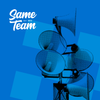Out of sight doesn’t mean in sync.
Remote and hybrid teams aren’t failing because they’re remote. They’re drifting—slowly, silently—because the systems that kept them aligned in person haven’t been rebuilt for distributed work.
Slack threads can’t replace hallway catch-ups. Zoom can’t replace shared rhythm. And if your team’s rituals weren’t strong before, remote work doesn’t expose the cracks—it widens them.
This is drift: the slow unraveling of alignment that feels like friction, fog, and fatigue. Work still ships. Projects still move. But energy drops. Ownership blurs. Trust starts to fray—and no one quite knows why.
When drift takes hold
It doesn’t hit all at once. Drift creeps in.
- Slack fatigue sets in—messages get skimmed, not absorbed.
- Decisions happen, but never get documented.
- Roles go fuzzy. Work gets done twice—or not at all.
- Projects move, but everyone’s rowing in slightly different directions.
You don’t see a breakdown—you feel a drag.
And in remote teams, drag becomes disconnection fast. Because when we can’t see each other, we start to guess. And guessing kills momentum.
Zappos and the drift of misguided autonomy
In 2014, Zappos adopted Holacracy—a management system that eliminated job titles and hierarchy in favor of self-organizing teams. The intent was empowerment. The result was drift.
Without clear roles, collaboration faltered. Without defined decision-making systems, things slowed. Fourteen percent of the company took a buyout. Why? Because structure matters—and autonomy without alignment creates chaos.
Remote work didn’t break Zappos. But a lack of structure did.
Why remote amplifies misalignment
When your team isn’t co-located, assumptions multiply. Silence gets misread. Updates get lost. And culture? It starts to feel like background noise instead of a guiding force.
That’s why remote teams need stronger systems across all three angles of Teamangle:
- Communication: The Signal — Remote teams can’t rely on osmosis. Clarity, consistency, transparency, and repetition are essential. If you don’t know whether your message landed, assume it didn’t.
- Collaboration: The Structure — Collaboration in person can be fluid. Remotely, it must be defined. That means roles, expectations, handoffs, and decision frameworks that leave no room for guessing.
- Culture: The Force Field — Without shared space, culture becomes visible only in behavior. Inclusion, trust, and psychological safety don’t happen passively—they have to be designed, modeled, and maintained.
GitLab got it right
GitLab, a fully remote company with over 1,300 employees in 65+ countries, didn’t try to mimic in-office behavior. They built from scratch.
• Their 2,000+ page public handbook codifies expectations and norms.• Asynchronous communication is the norm—not the exception.• Decision rights, feedback loops, and cultural values are documented, not implied.
They didn’t make remote work. They engineered it.
Now compare that to Yahoo, which famously banned remote work in 2013. Why? Leadership said collaboration and innovation were suffering. But the issue wasn’t location—it was that they never rebuilt the systems.
Figma took the opposite route: they doubled down on asynchronous critique, transparent decision-making, and lightweight rituals. Their internal alignment became just as strong as their product’s reputation.
It’s not where you work. It’s how you work.
Remote isn’t the problem—your systems are
At Same Team, we work with remote and hybrid teams every day. And we’ve seen this pattern repeat:
- Teams don’t know they’re drifting.
- Leaders feel it, but can’t prove it.
- Burnout and confusion show up as “motivation problems.”
- The fix is more meetings instead of better systems.
We built Teamangle to stop that cycle.
The Diagnostic gives you a heat map of how your team is really doing—across Communication, Collaboration, and Culture. It shows you where misalignment is hiding and where drift has taken hold. No fluff. Just structural truth.
And the Playbook gives you the tools to reset—not with more meetings, but with clarity, rhythm, and shared expectations.
T L ; D R — Remote and hybrid work didn’t cause your team to drift—weak systems did. If collaboration feels forced, communication feels scattered, or culture feels vague, don’t default to proximity as the fix. Use Teamangle to see where the cracks are, reset how the team works, and rebuild trust through structure—not vibes.






